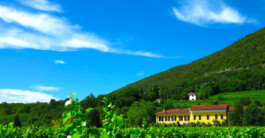The older vineyards, over sixty years old, have provided the scions for the graft selection of new plants, in order to perpetuate the original quality of grapes of decades old plants. The vines, all at an altitude ranging between 95 to 160 meters a.s.l. are managed with strict breeding forms (Triton) and there is a high plant density (up to 5600 stumps per hectare).



The soil is uniformly composed of marls and stratified sandstones of Eocen origin (50 million years old) which erosion has formed the typical clayey soil called Flisch of Cormons, most commonly called Ponca, universally recognized among the most suitable for the vine cultivation.

Factors such as the low production of each plant, the timely and meticulous care to which it is subject, the natural fertilization and the mechanical control of the weeds between and on the rows, together with the application of the most restrictive European standards for the reduction of pesticides (Reg. EEC 1257/99) lead to the cellar of Castel San Mauro, with its manual harvesting in boxes, healthy grapes and high organoleptic qualities.
The older vineyards, over sixty years old, have provided the scions for the graft selection of new plants, in order to perpetuate the original quality of grapes of decades old plants. The vines, all at an altitude ranging between 95 to 160 meters a.s.l. are managed with strict breeding forms (Triton) and there is a high plant density (up to 5600 stumps per hectare).



The soil is uniformly composed of marls and stratified sandstones of Eocen origin (50 million years old) which erosion has formed the typical clayey soil called Flisch of Cormons, most commonly called Ponca, universally recognized among the most suitable for the vine cultivation.

Factors such as the low production of each plant, the timely and meticulous care to which it is subject, the natural fertilization and the mechanical control of the weeds between and on the rows, together with the application of the most restrictive European standards for the reduction of pesticides (Reg. EEC 1257/99) lead to the cellar of Castel San Mauro, with its manual harvesting in boxes, healthy grapes and high organoleptic qualities.
Email: info@castelsanmauro.it
Tel: +39 328 9158033
nihil opus
© 2022 | CASTEL SAN MAURO di Manuele Mauri - P.IVA 00549350312 | Design e comunicazione: Leonardo Lenchig @ graphicopera.it | Privacy Cookie Policy
Email: info@castelsanmauro.it
Tel: +39 328 9158033
nihil opus
© 2022 | CASTEL SAN MAURO di Manuele Mauri - P.IVA 00549350312 | Design e comunicazione: Leonardo Lenchig @ graphicopera.it | Privacy Cookie Policy